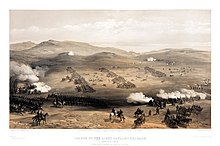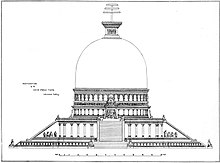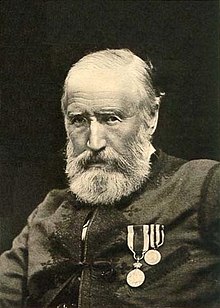|
William Simpson (Scottish artist)
William Simpson (28 October 1823 – 17 August 1899) was a British artist, war artist and war correspondent.[1] Life Born into poverty in Glasgow, Simpson went on to become one of the leading 'special artists' of his day, and sketched many scenes of war, culture and architecture around the world, for the Illustrated London News. His early years were difficult, living in a house with an abusive and alcoholic father, and in 1834 he was sent to live with his grandmother in Perth.[2] Simpson's only formal schooling took place during this period and within a few years, he was working as an apprentice in the Glasgow lithographic firm of Macfarlane.[3] The artist stated later that "this was the turning point which changed all my boyish intentions."[2] In Glasgow he attended the Andersonian University and the Mechanics' institute in the evenings, hearing lectures on science and engineering.[2] These institutions provided educational lectures to working men.  Crimean War After the outbreak of the Crimean War in 1854, he was given the task of creating an image of the Alma based on various accounts so that it could be lithographed by another London publisher, Lloyd's. He also put sketches sent from the Baltic onto stone for the firm of Colnaghi. In anticipation of the fall of Sebastopol, Lloyd's had him prepare an image of the fall of the town so that it could be published upon news of its actual capture. This presented a challenge to Simpson as he had little information about Sebastopol. He occasionally spoke with Mr. Day of Day and Son about the need to have sketches drawn at the front. Shortly thereafter, Colnaghi's contacted Simpson and invited him to go out to the Crimea and make sketches for the company.[3] Simpson arrived off the Crimean peninsula on 15 November 1854 and could hear distant firing. While he had missed the early battles, he was able to record the events before Sebastopol. He made numerous acquaintances who helped him with details for his pictures, but he was also struck by the plight of the common soldiers, "miserable looking beings...covered with mud, dirt, and rags," he wrote. He socialised with many officers, including Lord Raglan and Captain Peel; he also met Roger Fenton who took his photograph. In May 1855, Simpson accompanied Raglan on the expedition to Kertch which was captured on the 24th, but was back in time to observe the first attack on Sebastopol in June. On the night of the 17th, he crawled out of a trench to view the attack. He wrote, "It was a wild orchestra of sound, never to be forgotten." He was still at the front when the city surrendered, and he quit the Crimea in the autumn of 1855.[3]  Throughout his time at the front, he would send back his watercolours to London where the lithographers of Day & Son would transfer them to stone. Simpson was paid 20 pounds for each picture. For the colour, a separate stone was used for each tone. Colnaghis exhibited some of the watercolours including a show at the Graphic Society in February 1855. The first advertisements for the lithographs appeared in May 1855 and in the following month, a second series was announced.  In all, the Colnaghis produced two large portfolios containing over eighty lithographs entitled The Seat of the War in the East. Two thousand copies of the complete set were produced. Simpson dedicated the series to Queen Victoria whose patronage he enjoyed for the rest of his life, and he was a frequent visitor to Windsor Castle and Balmoral. So popular were his pictures that he became affectionately known at 'Crimean Simpson'. There was a plan for the watercolours to be purchased for the nation but this came to nothing and they were sold off by the Colnaghi's. India In 1857, he was sent to India to sketch scenes relating to the recent Sepoy Revolt, which is also described as the Indian Rebellion of 1857.[4] The idea was to produce an illustrated publication similar to the Crimean portfolio, and Simpson had discussed the possibility with Mr. Day. The artist arrived at Calcutta on 29 October 1859, and travelled in Punjab, Sutlej, Bengal, Lucknow and Cawnpore, central India, the Himalayas, Kashmir and Madras. In February, 1862, he left Bombay and arrived in London only to find that Day and Son could not afford to produce a portfolio. Nevertheless, a large volume of coloured lithographs was published under the title India Ancient and Modern. He was commissioned by Day & Son to visit these parts of India and record the places affected by the momentous events of the 'Mutiny' of 1857. Before leaving, he spent 'a considerable time in the library of India House, then in Leadenhall Street, looking over books about India, such as Daniels', to see what had been already done, and to get hints as to places I ought to visit'.[2] The set of lithographs produced, based on his watercolours, was intended to rival David Roberts' The Holy Land in scope. However, the project never came to fruition, following the financial collapse of Day & Son, due to the rise of wood engraving. By 1866, Simpson had delivered 250 watercolours to Day & Son and these were subsequently sold off as bankrupt stock.[3] Only 50 had been prepared as chromolithographs, and were published in 1867 as India Ancient and Modern. A series of illustrations of the country and people of India and adjacent territories. For Simpson this was little consolation: 'So the great work on India, on which I had bestowed so much time and labour, never came into existence...'.[2] Illustrated London NewsIn 1866, Simpson was contacted by The Illustrated London News to do some sketches of the Prince of Wales, on a visit to the Duke of Sutherland at Dunrobin Castle. Afterwards, the paper asked him to go to St. Petersburg and cover the Prince of Wales's attendance at the marriage of the Czarevich, afterward Emperor Alexander III.[3] Simpson became a “special artist”, illustrating the news for the paper. Abyssinia In 1868, Simpson travelled to Abyssinia covering the British expedition to Abyssinia.[5] [6] Initially, his employer, The Illustrated London News used sketches supplied by one of the soldiers on campaign, Colonel Baigrie, but as his pictures were mostly landscapes, the paper felt that Simpson could add more life to the accounts of the war. The artist arrived at Suez on 18 June 1868, but by the time he neared the front, news came that Magdala had fallen to the Anglo-Indian force. Nonetheless, he was able to observe the retreat of the Abyssinian army, and the remains of the royal quarters of Emperor Tewodros II at Magdala, which had been looted by the British Army.[7] He arrived back at Dover on 2 July 1868 and the Illustrated London News published a special folio volume on the British expedition to Abyssinia containing many of Simpson's and Baigrie's drawings.[3] Franco-Prussian War and the Paris Commune In 1870, Simpson went to France to sketch the war with Prussia. On 25 July, he headed for the front by going from Nancy to Metz. In Metz, several journalists had already been arrested on suspicion of spying, and Simpson had to be careful while making his sketches. He had to be creative in getting his sketches to London, and began using cigarette papers. As he said: "One could do a great deal on a book of that kind, and in the event of being apprehended, could make a cigarette of the sketch and smoke it before the eyes of one's accusers.".[2] In early August, he observed the arrival of the wounded after the Battle of Forbach-Spicheren. Later while sketching a coach, he was surrounded by soldiers and arrested on suspicion of being a spy but he convinced the French authorities that he was a 'special artist'. At the police station, his sketches were examined, and he was finally released. Upon news of the surrender at Sedan, Simpson travelled to sketch the battlefield from the windows of a nearby chateau. In November 1870, he returned to London but was back in France in April 1871 to observe the events around Paris, where he was once again suspected of spying but was allowed to go free. On 27 April, he visited Paris and spent four weeks there, sketching the fortifications and the events of the Paris Commune.[3] He was back in London by 11 June 1871. Meeting the SunIn 1872, William Simpson left for a long trip to Egypt, China, Japan & USA. The sketches he made were engraved for the Illustrated London News, and were reproduced using the heliotype process in a volume named Meeting the sun: a journey all round the world through Egypt, China, Japan and California, including an account of the marriage ceremonies of the emperor of China.[8] [9] In Beijing he sketched the Chinese Emperor's wedding festivities.[10] In 1873, Simpson happened to be in San Francisco when, on 11 April, Kintpuash ('Captain Jack') and his Modoc followers murdered Brigadier-General Edward Canby and Methodist minister Eleazar Thomas at a peace parley. Simpson interrupted his world tour and journeyed up to Tule Lake and the lava beds at the California/Oregon border to make sketches of the Modoc War. His sketch of the Canby/Thomas assassination scene was the signature graphic representation of the 1873 Modoc War. In 1874, he was elected an Associate of the (soon to be Royal) Institute of Painters in Water Colours. In 1875, he accompanied the Prince of Wales to India, and arrived in Mumbai on 30 October. The tour was designed to strengthen ties between Britain and India, which was then ruled by the British Crown. The Prince collected a large number of items of Indian art during the tour, which were often presented to him by various local rulers during receptions and events.[11] William Simpson wrote about the tour in his autobiography: "I have often described the Prince's tour in India as four months of the Lord Mayor's show".[2] In 1877, visited Athens, Mycenae and Troy, to document the excavations of Schliemann.[3] Afghan War  On 15 October 1878, Simpson left London en route to Afghanistan to provide illustrations of the Second Anglo-Afghan War. Travelling via Lahore and Peshawar, he passed through the Khyber Pass and witnessed the 'first shot' fired at the Battle of Ali Masjid.[2] He became friendly with Sir Louis Cavagnari who encouraged Simpson with his explorations of ancient Buddhist stupas in and around the Jalalabad Valley. While the Peshawar Valley Field Force was encamped at Jalalabad and later Gandamak, Simpson was allowed to have some soldiers to help him excavate Ahin Posh Tope and several other sites.[12] As he excavated the Ahin Posh stupa in February 1879, he cleared the base of the stupa and dug a tunnel to the centre, where he discovered important relics and deposits, now in the British Museum.[12] He also made drawing reconstitutions based on his findings.[12] On one occasion, he was shot at by an Afghan but the bullet just missed. At Gandamak, he met the photographer John Burke and his counterpart at The Graphic, Frederic Villiers, and after the departure of Archibald Forbes, Simpson took over the task of supplying the Daily News with accounts of the campaign. In May 1879, he observed the signing of a peace treaty at Gandamak which ended the war for the time being.[3] When it was decided to send a mission to Kabul, Simpson applied to go but was turned down. His primary interest in accompanying the mission was to visit the giant Buddhas at Bamyan, but had he gone to Kabul, he probably would have been killed liked the rest of the mission. It was this event which precipitated the second part of the war. Simpson returned to London in the summer of 1879. Upon his arrival, he visited the offices of the Illustrated London News on the Strand and collected all his sketches and watercolours which he proceeded to mount in two large albums. He also presented several papers to various learned societies on such aspects as Buddhist prayer wheels, sculptured topes and ancient remains in the Jalalabad Valley. In the same year he was elected a full member of the Institute of Painters in Water Colours. In 1884, Simpson returned to Afghanistan with General Sir Peter Lumsden as part of the Afghan Boundary Commission. It was his last major trip abroad. Having spent the winter on the Afghan border, he set off for London in February 1885. As a result, he narrowly missed the Panjdeh incident in March, in which several hundred Afghans were killed by the advancing Russian army. Simpson reached London, therefore, at a time of great interest in the Boundary Commission and feverish speculation about the possibility of war with Russia. He received invitations to visit Lord Granville, then the Foreign Secretary, as well as various members of the royal family.[13]  Throughout the following decade, Simpson continued his travels on behalf of his newspaper covering such events as royal weddings and coronations. In 1890, he observed the opening of the Forth Bridge and caught a chill which was to have detrimental effects on his health.  MembershipWilliam Simpson was a member of a number of different organisations, reflecting his interests.
Family and deathSimpson married late in life to Maria Eliza Burt herself a portrait painter, and had one daughter, Ann Penelope born in 1884, who eventually emigrated to Australia. He died at home in Willesden, North London, on 17 August 1899 aged 75,[3] and was buried in Highgate Cemetery. Besides his war pictures, he covered state events, coronations, funerals, and other ceremonies. He was particularly interested in India and sketched scenes of the Kashmir Maharajas. He was a noted ethnographer and antiquarian, and wrote extensively on ancient religions, customs, and ancient artifacts. It is said that the Queen intervened to prevent him from going out to Italy in 1859, to cover the Austro-Sardinian War, for fear that he would get killed. Works by (books)
Works by (selected articles)
Exhibition catalogues
Notes
References
External linksWikimedia Commons has media related to William Simpson.
|
||||||||||||||||||||
